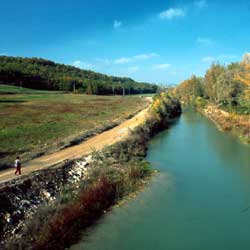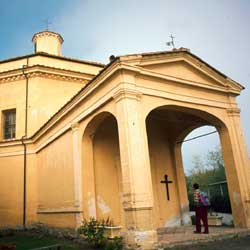Ond'io a lui: «Lo strazio e 'l grande
scempio
che fece l'Arbia colorata in rosso
tal orazion fa far nel nostro tempio».
Then I: «The carnage and the bloody flow,
That made discolour'd Arbia run in red,
Lifts in our shrine such orison of woe.»
(Inferno, Canto X, 85/87) |
 While
talking with Farinata degli Uberti, the poet recalls one of the bloodiest
clashes between the Guelphs and the Ghibellines, the battle that took
place on the hill of Montaperti in 1260, in which the Ghibellines exiled
from Firenze inflicted a humiliating defeat on the rival Guelphs. Dante
didn't himself take part in the battle, but as Parodi comments, "the
way Dante expresses himself shows that, although it had come to him second-hand
through the recollections of others, his eyes had witnessed the shocking
sight of that red flow of blood". And as the chronicles of the time
reported that "all the roads, and hills, and every watercourse seemed
a large river of blood", Dante, who was very familiar with the geography
of the area, came to the conclusion that the river Arbia, which flows
near Montaperti, had turned red from the blood. Several decades later,
the echoes and bitterness induced by the battle were still alive; in fact,
in Canto XXXII of The Inferno, when the poet comes face to face with Bocca
degli Abati, the man who betrayed the Guelphs in the battle, he wants
to inflict further punishment on him, hitting him hard on the face with
his foot: While
talking with Farinata degli Uberti, the poet recalls one of the bloodiest
clashes between the Guelphs and the Ghibellines, the battle that took
place on the hill of Montaperti in 1260, in which the Ghibellines exiled
from Firenze inflicted a humiliating defeat on the rival Guelphs. Dante
didn't himself take part in the battle, but as Parodi comments, "the
way Dante expresses himself shows that, although it had come to him second-hand
through the recollections of others, his eyes had witnessed the shocking
sight of that red flow of blood". And as the chronicles of the time
reported that "all the roads, and hills, and every watercourse seemed
a large river of blood", Dante, who was very familiar with the geography
of the area, came to the conclusion that the river Arbia, which flows
near Montaperti, had turned red from the blood. Several decades later,
the echoes and bitterness induced by the battle were still alive; in fact,
in Canto XXXII of The Inferno, when the poet comes face to face with Bocca
degli Abati, the man who betrayed the Guelphs in the battle, he wants
to inflict further punishment on him, hitting him hard on the face with
his foot:
Se voler o destino o fortuna,
non so; ma, passeggiando tra le teste,
forte percossi 'l pié nel viso ad una.
Piangendo mi sgridò: «Perché mi peste?
se tu non vieni a crescer la vendetta
di Montaperti, perché mi moleste».
I know not, if from will, or chance, or fate,
But, as among the heads our course we take,
Hard with my foot the face of one I grate.
"Why tramplest thou on me," it weeping spake,
"Unless thou art arriv'd with added store
Of fierce revenge, for Montaperti's sake?" |
Nowadays the hill of Montaperti is a green expanse covered with cypresses
that further add to the beauty of the undulating land around Siena. There's
a pyramid-shaped monument at the summit of the hill, with some lines from
Dante carved into it, in memory of the bloody battle. The suggested route
runs almost entirely along quiet unpaved tracks and gives you an opportunity
to walk through one of the quietest corners of the Siena area, to pass
isolated red farmhouses and small settlements built on sunny slopes, and
to walk through cool woods on the ridges and fields used as pasture for
sheep.
From the Taverne d'Arbia roundabout, looking towards the bridge over the
river Arbia, you can see to the left a small surfaced road (for Presciano),
along which there are the red and white markers of footpath no. 2. Take
this road, which runs beneath the Siena-Bettolle link road and immediately
afterwards curve left on a rough unpaved track (red and white signs).
Walk up the track, passing several country farmhouses, till you come to
a group of rural buildings called Piancollina. Here there's a track going
to the right along the ridge in the direction of Mociano. Soon afterwards
this track widens and is flanked by cypresses, and leads to the villa
and the small, interesting chapel of Mociano. Sticking to the main path,
carry on along the ridge of the cultivated hills which lie to the east
of Siena until you get to the surfaced Pieve a Bozzone road. Turn right
along this quiet road and follow it until you reach a main junction.
 Go straight on in the direction of Vico d'Arbia and Montaperti, walking
along the unpaved road. Soon you come to a sign for Vico d'Arbia: ignore
it, descend instead to a bridge over the river Arbia, and then climb again,
crossing through a small wooded area till you reach a crossroads. Cross
the asphalt road and carry on the other side along the unpaved road that
leads to Montaperti (there's a sign). A short distance further on you
come to a junction. If you go straight on, you come immediately to the
small rural village of Montaperti, where there's also a church. The path,
however, goes right, and takes you down to the plain below Montaperti,
in the direction of the hill of Monteapertaccio, which immediately appears
to the left with its tall green cypresses. You can't go wrong here, just
carry on along the straight, ancient cart-track which then curves to the
left at Monteapertaccio and goes through the village. Immediately afterwards,
having passed a large group of farm buildings, you come to a junction.
Go left, leaving the main cart-track and continuing till you're at the
foot of the hill; you reach the top by walking up a narrow path. At the
top there's a pyramidal monument to mark the battleground and a great
view of the succession of hills that make up the Chianti Senesi area to
the north and the Crete Senesi to the south. Climb back down the hill
and go back the way you came till you get to the junction for Taverne
d'Arbia. Turn left and go through the hamlet (the most typical feature
of rural farm buildings in the Siena hills is their colour, a very distinct
red which derives from the principal building material, terracotta bricks
produced above all in the Crete Senesi area), then begin to descend along
the panoramic ridge which gradually drops down to the Fosso Rigo. When
you come to a more important cart-track, take it, going left and following
it as it runs along on the flat. Near Presciano, it becomes surfaced and
soon you're back at Taverne d'Arbia.
Go straight on in the direction of Vico d'Arbia and Montaperti, walking
along the unpaved road. Soon you come to a sign for Vico d'Arbia: ignore
it, descend instead to a bridge over the river Arbia, and then climb again,
crossing through a small wooded area till you reach a crossroads. Cross
the asphalt road and carry on the other side along the unpaved road that
leads to Montaperti (there's a sign). A short distance further on you
come to a junction. If you go straight on, you come immediately to the
small rural village of Montaperti, where there's also a church. The path,
however, goes right, and takes you down to the plain below Montaperti,
in the direction of the hill of Monteapertaccio, which immediately appears
to the left with its tall green cypresses. You can't go wrong here, just
carry on along the straight, ancient cart-track which then curves to the
left at Monteapertaccio and goes through the village. Immediately afterwards,
having passed a large group of farm buildings, you come to a junction.
Go left, leaving the main cart-track and continuing till you're at the
foot of the hill; you reach the top by walking up a narrow path. At the
top there's a pyramidal monument to mark the battleground and a great
view of the succession of hills that make up the Chianti Senesi area to
the north and the Crete Senesi to the south. Climb back down the hill
and go back the way you came till you get to the junction for Taverne
d'Arbia. Turn left and go through the hamlet (the most typical feature
of rural farm buildings in the Siena hills is their colour, a very distinct
red which derives from the principal building material, terracotta bricks
produced above all in the Crete Senesi area), then begin to descend along
the panoramic ridge which gradually drops down to the Fosso Rigo. When
you come to a more important cart-track, take it, going left and following
it as it runs along on the flat. Near Presciano, it becomes surfaced and
soon you're back at Taverne d'Arbia.
| Time required |
4 hours, 30 minutes |
| Vertical height |
270 m |
| Maps |
Kompass 1:50.000, no.661, "Siena-Chianti-Colline
Senesi" |
| How to get there |
From Siena, take the SS. 326 (Siena-Bettolle
link road) in the direction of Perugia. There are road signs for Taverne
d'Arbia, which is the starting point. |
|